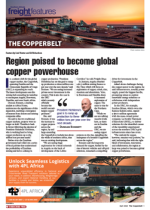In a seismic shift for the global copper market, the Copperbelt, spanning Zambia and the Democratic Republic of Congo (DRC), is expanding its reach. The latest development sees this mining hub extending its waistline to encompass Angola, Botswana, Namibia, and even South Africa.Duncan Bonnett, a leading analyst at Africa House, underscores the significance of this expansion, marking a resurgence of interest from donors and mining companies alike.He said in the two traditional copper markets, projects were no longer on hold. “Zambia is back in favour following the election of President Hakainde Hichilema, who is working hard to bring copper production up to the million-ton-per-year mark.”Before 2021 the Zambian government had rolled out a series of fiscal policies that undermined the profitability of Zambian mining and led to a slump in copper production. “President Hichilema has set the goal to ramp up production to three million tons per year over the next decade,” said Bonnett. “We are seeing increased private sector investment in the country. This is also the case in the DRC which recently officially became the world’s second-largest copper producer.”But, said Bonnett, it was the increase in copper projects across the region, by and large extending the Copperbelt to include just about the whole of southern Africa, that was an exciting development.“We are seeing huge exploration for critical minerals in Angola on the back of development of the Lobito Corridor,” he told Freight News.In January, Angola awarded a $5.7-million mining licence to Rio Tinto which will focus on exploration of copper, cobalt, zinc, titanium and aluminium. “Also, in Botswana and Namibia there is increased exploration of copper. The same is true for the Northern Cape.“While we are not talking massive levels here, as there are in Zambia and the DRC, we are seeing copper projects on the rise, signalling the emergence of a broader Copperbelt across the region.”Bonnett said the long-term demand for copper, fuelled by the rise of electric vehicles and off-grid solutions, remained a compelling driver for investment in the Copperbelt.Asked about challenges facing the copper sector in the region, he said infrastructure, notably power supply, posed the biggest hurdle, prompting mines to explore renewable energy solutions or collaborate with independent power producers.In the DRC, for example, Ivanhoe Mines, which owns the Kamoa-Kakula mine, signed a $450-million agreement with the state-owned power company, La Société Nationale d’Electricité (SNEL), to deliver solutions for the identified causes of the instability experienced across the southern DRC’s grid infrastructure since late 2022.“The outlook for copper, however, remains very positive,” he said, indicating that with the right blend of investment, innovation, and collaboration, the region at large was poised to become a global copper powerhouse.

